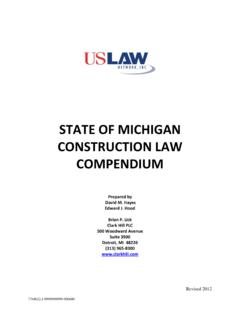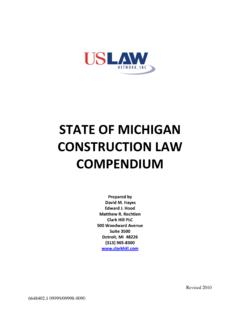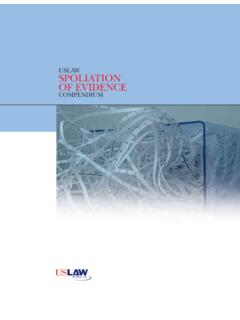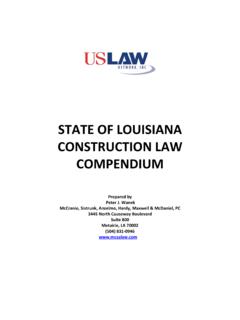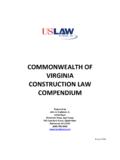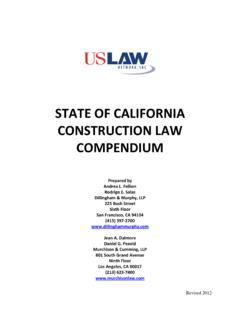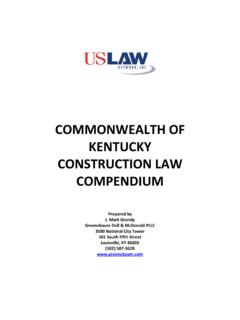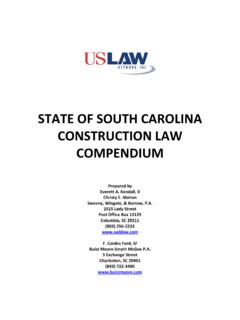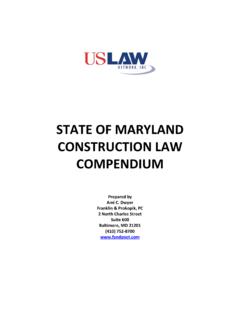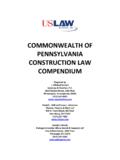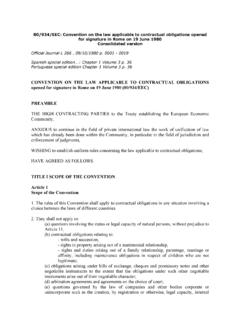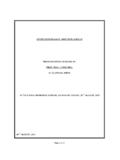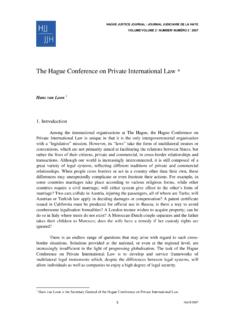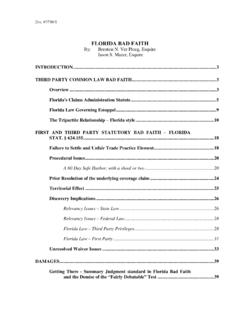Transcription of STATE OF OHIO CONSTRUCTION LAW …
1 STATE OF ohio CONSTRUCTION LAW compendium Prepared by Todd A. Harpst Roetzel & Andress, LPA 222 South Main Street Akron, OH 44308 (330) 376 2700 This compendium of ohio CONSTRUCTION law is intended only to provide the reader with a general outline of the ohio law as of the date this compendium is published and should serve only as a resource for general information. ohio law with regard to CONSTRUCTION matters changes frequently as a result of the development of case law, and there have been some very recent ohio Supreme Court decisions impacting the CONSTRUCTION industry that have not yet been fully integrated into ohio common law. Therefore, the reader should follow up with specific legal research once a topic of interest has been identified. ohio is also a modified comparative fault STATE for purposes of tort reform, and there have been some very recent legislative changes in the torts area that will have an indirect impact on tort claims involving the CONSTRUCTION industry as well.
2 Legislative changes and court decisions have recently modified and limited the collateral source rule and have significantly limited joint and several liability. The ohio legislature has recently enacted reforms to separate economic and non-economic damages, and in certain cases, have implemented damage caps on bodily injury claims for non-economic damages, which have been upheld by the ohio Supreme Court. Therefore, in those cases where the tort reforms are important, the reader is advised to consult with an attorney familiar with ohio law on this topic for the most current information. I. BREACH OF CONTRACT A. Statute Of Limitations & Choice of Law Disputes concerning ohio CONSTRUCTION projects must be litigated in ohio , subject to ohio law, regardless of the choice of law provision or forum selection clause in the contract. (D)(1) &(2).
3 These statutory requirements cannot be waived. It may be possible to challenge such statutes when federal pre-emption is an issue, such as when the forum selection clause is part of an arbitration clause subject to the Federal Arbitration Act. The statute of limitations for a contract claim will vary depending on the form of the contract. For example, the statute of limitations for a written contract is fifteen years, pursuant to A claim based on the breach of an oral contract has a six-year statute of limitations period. See Most breach of warranty claims have a four-year limitations period. See Claims that fall under the ohio Consumer Sales Practices Act, as would a residential CONSTRUCTION or home improvement contract must be brought within two years of the time the cause of action accrues. ohio follows a ten year statute of repose. See, A cause of action for breach of contract accrues when the breach occurs, regardless of the aggrieved party's lack of knowledge of the breach.
4 See ; See also Midwest Specialties, Inc. v. Firestone Tire & Rubber Co.(1988), 42 ohio 6. Parties may contract to reduce the period of limitation to not less than one year. See Hahn v. Jennings, 10 Dist. App No. 04AP-24, 2004 - ohio - 4789. Similarly tolling agreements are enforceable in ohio . Tolling agreements are contractual agreements that extend the statute of limitations for pursuing a claim. An effective tolling agreement will identify (a) the parties to the dispute; (b) the applicable claims, damages, and defenses; and (c) a specification of the time period during which a lawsuit should be filed, or other means of dispute resolution sought. 2 B. Discovery Rule Typically, a cause of action accrues at the time the wrongful act was committed. Collins v. Sotka (1998), 81 ohio 506, 507, citing Kunz v. Buckeye Union Ins. Co. (1982), 1 ohio 79. However, ohio s discovery rule provides an exception to this general rule, providing that a cause of action accrues at the time when the plaintiff discovers or, in the exercise of reasonable care, should have discovered the complained of injury.
5 Investors REIT One v. Jacobs (1989), 46 ohio 176, 179, 546 206. This is particularly important in the CONSTRUCTION context where there may be latent defects in a project that are not immediately observable. Accordingly, in ohio , an action against a developer-vendor of real property for damage to the property accrues when it is first discovered, or through the exercise of reasonable diligence it should have been discovered, that there is damage to the property. Harris v. Liston (1999), 86 ohio 203, 207. (where the discovery rule was applied to a negligence action). The question of what is reasonable is a factual determination to be determined by a judge or jury. Crawford v. Wolfe, 4th Dist. No. 01CA2811, 2002- ohio -6163, at 21-22. The discovery rule typically will not apply in contract claims, because the statute of limitations for written contract breaches is so long this is rarely a concern. It will apply in tort claims, which are the preferred claims when the aggrieved party can not establish privity of contract with the target defendant.
6 There are notable exceptions to this rule that do not recognize a discovery rule, particularly in breach of warranty claims. Please consult local counsel when in doubt on the applicability of the discovery rule. C. Substantial Performance A party must substantially perform its obligations under a contract to recover for breach of contract. [M]ere nominal, trifling or technical departures are not sufficient to constitute breach. Hansel v. Creative Concrete & Masonry Constr. Co., 148 ohio App. 3d 53 (2002).A contractor does not breach a contract when the unperformed or wrongfully performed work does not destroy the value or purpose of the contract. Id. In order for a plaintiff s claim to be actionable, ohio requires that a material contract breach occur, and courts will allow proof of substantial performance in most cases. Enterprise Roofing & Sheet Metal Co. v. Howard Inv. Corp. (1957), 105 ohio App. 502, 504-5 152 807.
7 D. Cardinal Changes A cardinal change is a single change or group of changes that are so profound and have such a large impact on the project that it can be said that the original contract no longer exists. This is treated as a breach of contract. The cardinal change doctrine allows a prime contractor or subcontractor to recover damages for breach of contract when an owner makes changes to the specifications of the contract which are so significant, that they cannot be absorbed by the changes clause included in the original contract. The doctrine developed in the federal contract arena was to allow contractors a basis for equitable adjustments when necessary. However, states have not embraced the doctrine as warmly. ohio in particular has never recognized the cardinal change doctrine, and the federal courts in ohio that have passed on this issue have indicated ohio law will not recognize it.
8 See, EBL v. Marous Brothers Const., 2002 WL 32818011 ( ohio 2002). 3 E. Drug-Free Compliance Since 2007, ohio law has required that all contractors and subcontractors enroll in a drug-free workplace program to be eligible to perform public CONSTRUCTION work in ohio . Failure to comply with this requirement is considered a breach of contract and may prevent a contractor from receiving a public contract for up to five years. F. Third Party Beneficiaries and Privity of Contract Generally, there must be privity of contract between parties in order to recover damages under a contract or negligence theory. Thomas v. The Guarantee Title & Trust Company (1910), 81 ohio St. 432, 442, 91 183. An action for breach of contract by a third party can be brought only where the parties to a contract intended to benefit the third party. Hunter Building & Renovation v. Miller, 8th Dist. App.
9 No. 67131, 1996 WL 65811, at *3. Only a party to a contract or an intended third-party beneficiary of a contract may bring an action on a contract in ohio . Brewer v. H & R Concrete, Inc. 2nd Dist. No. 17254, 1999 WL 49366, at *2; Mergenthal v. Star Banc Corp., 12th Dist. No. CA96-10-107, 122 ohio 100, 103-104. A landowner can be a third-party beneficiary of a subcontractor's performance, but generally, landowners and subcontractors are not in privity of contract. Brewer at *2. There must be evidence, on the part of the subcontractor, that he intended to directly benefit a third party, and not simply that some incidental benefit was conferred on an unrelated party by the promisee's actions under the contract. Mergenthal at 103-107. ohio does not permit a subcontractor to sue a design professional for errors and omissions in design drawings that caused the subcontractor delays or disruptions in performance unless the subcontractor and design professional are in privity on contract.
10 Floor Craft Coverings, Inc. v. Parma Community Hospital, 50 ohio 1 (1990). G. Pay-if-Paid and Pay-when-Paid ohio recognizes the difference between pay-if-paid and pay-when-paid clauses in CONSTRUCTION contracts. The pay-when-paid clause represents an unconditional promise to pay a subcontractor within a reasonable time after the general contractor is paid by the owner. A pay-if-paid provision on the other hand, makes the general contractors receipt of payment from the owner an absolute condition precedent to its obligation to pay the subcontractor. Under a pay-if-paid provision, the subcontractor assumes the risk of owner non-payment, whereas when a pay-when-paid provision, the general contractor assumes the risk of owner non-payment. Chapman Excavating Co., Inc. v. Fortney & Weygandt, Inc., 2004 WL 1631118 (8th Dist. 2004). However, because pay-if-paid clauses could result in a forfeiture by the subcontractor in the event of owner non-payment, such clauses tend to be strictly construed, narrowly applied, and require some evidence that it is clear and unambiguous as to its true intent of imposing the risk of non-payment on the subcontractor.
